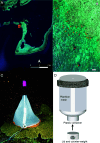Allee effects limit coral fertilization success
- PMID: 39680760
- PMCID: PMC11670066
- DOI: 10.1073/pnas.2418314121
Allee effects limit coral fertilization success
Abstract
Coral populations are being progressively thinned by climate change, which elevates the risk of reproductive failure from Allee effects during fertilization. Studies have shown that fertilization success improves during more intense and synchronized spawning, but the local dependence of fertilization on coral density remains unknown in wild populations. Here, we measure the fertilization success of individual colonies of the common table coral, Acropora hyacinthus in Palau, Micronesia. We find strong evidence of spatial Allee effects such that fertilization averaged 30% when colonies were in close proximity (<0.5 m), but this declined rapidly to less than 10% at a separation of 10 m and virtually zero by 15 to 20 m. The distance of a nearest neighbor conspecific, gravid colony is a better predictor of observing Allee effects than local colony density measured at several alternative scales (2 to 10 m). Spawning synchrony increases when corals are in close proximity, which may reinforce Allee effects as reproductive colonies become further separated. Fertilization success declined nearly threefold on a second night of spawning with higher wind despite there being more intensive spawning of colonies, highlighting the potential importance of prevailing weather in driving the outcome of mass spawning events. Overall, we find that the local population of A. hyacinthus achieved 71% of its fertilization potential. Further studies of spatial patchiness in coral populations are needed to generalize the likelihood of Allee effects, how climate change impacts reproductive function on reefs, and opportunities for restoration to safeguard reproductive success by reconnecting depleted coral populations.
Keywords: coral reef; reproduction; resilience; spawning; threshold.
Conflict of interest statement
Competing interests statement:The authors declare no competing interest.
Figures




References
-
- Smith K. E., et al. , Biological impacts of marine heatwaves. Annu. Rev. Mar. Sci. 15, 119–145 (2023). - PubMed
-
- Suding K. N., Gross K. L., Houseman G. R., Alternative states and positive feedbacks in restoration ecology. Trends Ecol. Evol. 19, 46–53 (2004). - PubMed
-
- Hock K., et al. , Transient dynamics mask the resilience of coral reefs. Theor. Ecol. 17, 1–12 (2023).
-
- Kramer A. M., Dennis B., Liebhold A. M., Drake J. M., The evidence for Allee effects. Popul. Ecol. 51, 341–354 (2009).
MeSH terms
Grants and funding
LinkOut - more resources
Full Text Sources
Medical

